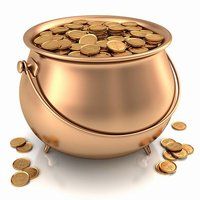 In this article, we shall discuss the over-hyped claim that gold is the ultimate store of wealth. Gold is accorded such esteemed honors freely, but where are the facts? Is it true that gold’s value would protect its holders from the ravages of inflation? Is it true that our wealth, our hard work and sweat as it’s often called, can be stored ‘inside’ a piece of yellow metal?
In this article, we shall discuss the over-hyped claim that gold is the ultimate store of wealth. Gold is accorded such esteemed honors freely, but where are the facts? Is it true that gold’s value would protect its holders from the ravages of inflation? Is it true that our wealth, our hard work and sweat as it’s often called, can be stored ‘inside’ a piece of yellow metal?
The yellow metal is often hyped as very stable in value, but is there any truth to it? Take a look at the value of gold, priced in US Dollars below.
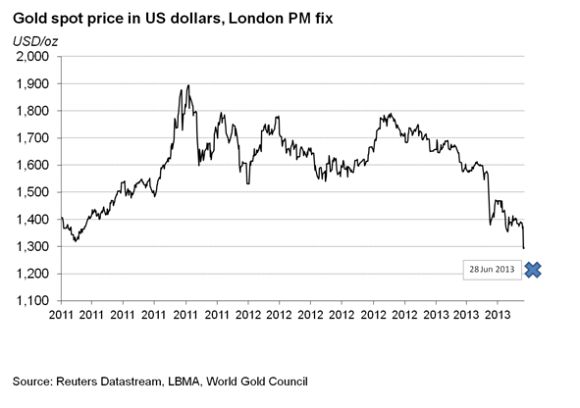
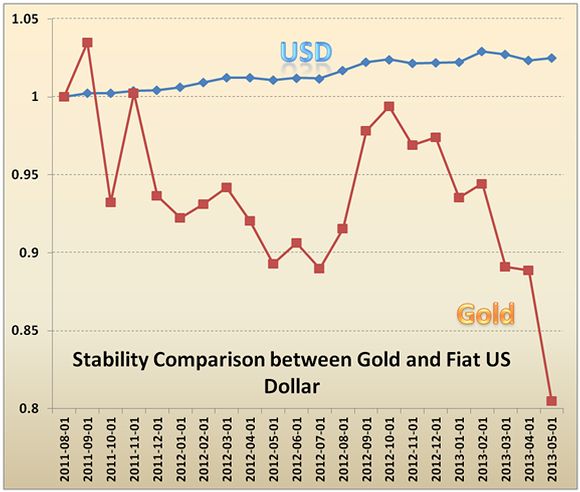
(Data obtained from the Federal Reserve monthly CPI and World Gold Council)
Which is the rock of stability? Clearly the fiat currency is. The reason this is so, is very simple. The dollar is actively controlled by the central bank, gold is not. What does ‘controlled’ mean? To find out, you will have to download and read the Conundrum of Assets and Money at our website.
The value of gold, by itself, is erratic and unstable. Therefore storing one’s wealth into gold, is bound to be a bad decision, no matter what. In 2011, gold’s price dropped by 25% in a matter of two weeks. Will you be happy if your EPF savings shrink in value by a massive 25%, in two weeks? It took you years to save that much, and you will need more than ten years probably, just to recover from this loss, without any profit whatsoever. This illustrates clearly the instability inherent in gold, its failure as money and this was the real reason why our grandfathers threw it away for good. However our warnings and explanations were brushed aside, and people continued to adore and idolize their shiny metal and hail it as the ultimate savior, better than fiat currencies all over the world. They thought it will save them from the upcoming “hyperinflation”. Well, it did not.
Once again, today in 2013, it dropped by the largest ever on record, by a massive 30+% in the space of just a few days. Millions of gold hoarders were affected, and they could not do anything except watch. No gold buyer, not a single one, since mid 2011, would have made a single cent from their ‘investment’ in the yellow metal especially if they bought physical gold. That’s right folks, not a single one. We are talking about hundreds of millions of people. These group of people would suffer tremendously, possibly until the next generation. This calculation is made by assuming that those who bought them, plan to sell them only after it appreciate 20% (as gold dealers will charge as much as 15% to 20% premium), or only after a year of purchase. The recent large drop erased more than two years of gains, essentially returning the market back to 2009.
Now compare that to the US dollar, the world’s de facto currency. Its value remained stable throughout the period, made possible by the monitoring done by the Federal Reserve. The main advantage of a fiat currency is that it is being controlled actively, by the issuer. Gold on the other hand, has no control whatsoever, and is very open to large-scale manipulations.
[We need to mention the performance of gold compare to that of the stock market as well, it is between night and day. For example the DJIA stock market’s has returned a magnificent 55% over the period excluding dividends (which is also significant). Gold on the other hand, delivered zero return since 2010). ]
This is a chart comparing gold’s price at its peak, to that of the stock market.
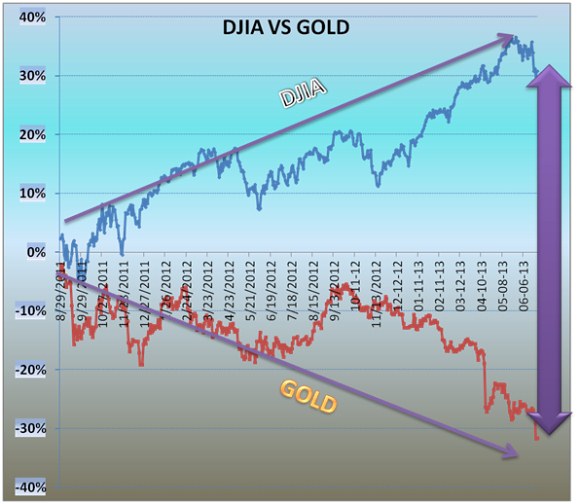
In order to simply catch up to the DJIA growth, gold price must elevate itself by a humongous amount of 91% from its current level. Again, for this to occur in the short to medium term is almost nonexistent. Can you now imagine gold’s price going up to USD2,350 in a few short weeks? The chance for this occurring is zero, and the chance for it to occur in the next few years would be very remote as well. Therefore gold hoarders had permanently lost to the stock market and are left in the dust. These hoarders are unlikely to come out from their losses, ever. Again, imagine that if you put 150,000 dollars in the stock market in 2011 and another set of equivalent amount into gold bars, today you would have more than 204,000 dollars sitting pretty in the stock market, but only 98,000 as gold bars. Your gold bars must grow by almost 100% just to catch up. As we mentioned just now, the chance for that occurring anytime soon is almost nil.
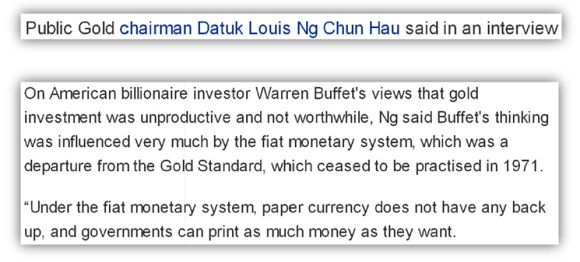
Apparently, Buffett was right all along. He made a handsome profit in the stock market, not just in 2013, but in 2012 and 2011 as well. Putting money into great companies with visions to change the world into a better place is a rewarding endeavor rather than keeping pieces of metal inside a vault somewhere for individualistic benefit.
According to the Public Gold chairman, government can print as much money as they want. However if they could, they would have done it already. Why would they bother with bonds and borrowings if they could simply print tons of money?
We also showed that fiat currencies do have value; they are always properly backed up. To understand this part, we created video presentations for easy understanding at our website. It is really easy and simple in reality. No money is ever printed out of thin air.
What is the real purpose of money? We articulated in our book series, that money is simply a medium of exchange, to enable trades between economic participants. Money must be stable, to allow a trade to occur to completion, without penalizing the seller or the buyer. For example, a trade of selling/buying a house may take up to three months to close from the negotiation stage, all the way to the actual payment and title transfer. Within these three months, the price or the value of money must remain stable, otherwise the trade could fail.
Under the defunct gold standard, the seller must contemplate losing 25% of the sale’s price, anytime during the trade, due to the possible sudden change in the value of gold. A seller who is selling his house worth $500,000 may lose up to $125,000 and pocketed only $375,000, if gold’s price drops suddenly during the trade. In fact, he may need to top up additional $125,000 to settle his outstanding loans, thereby losing way more than he bargained for. To avoid this trade from eating him alive, the seller would buffer himself with a very large premium over the selling price, making everything even more expensive for the buyer. This is one reason why Islamic fixed loans are expensive. We explained the unfairness of this type of loans in our writings.
The least the currency could do is to remain as stable as possible, until the trade is completed. Well, the majority of our trades would close within minutes, some in a few days. But rarely, we need more than several months. Therefore price stability concerns of the central banks, diminishes greatly after a window of several months. There is no point in keeping the price unchanged for five years for example, because there is hardly any trade requires such a long period to complete. More than 10 years? Probably zero trade requires such a long overdrawn period. Therefore, the central bank focuses their eyes to the short and the medium term period. If the short and the medium term is rather stable, the long term would take care of itself and will actually reflects the future expected inflation rate. So is it even proper to compare the value of today’s dollar, with the value of the dollar of ten years ago? Or 50 years ago? The answer is it is not, because the dollar of today’s, is greatly different than the dollar of yesteryears. Comparing them would be very confusing and misleading (we have shown this in one of our books). We coined the term, “temporary store of value” as one of the function of an ideal money. Any currency that can fulfill this requirement beautifully, would fulfill one of the three criteria of an ideal money. Is it fair for us to compare the price of a car of 50 years ago, to that of today’s? No doubt the price has gone up, but how about the speed, the fuel efficiency and the comfort of today’s modern cars? They are no longer comparable, unless plenty of corrections to quality etc are made. Did you even know that the cars of the 70s consumed more petrol staying idle, than the cars of today coasting along the highway at the speed of 90 km/h? These cars are no longer comparable, they are essentially very different.
Thus the claim that the dollar has lost 95% of its value from the year 1913, is simply ‘bogus’ and misleading. If such is the case as claimed, today’s generation won’t be able to buy their tv sets, their smartphones, zero emission cars etc. because their incomes would have shrunk by 95%. Imagine your salary shrink by that much, what can you buy with it? In reality, the ‘shrinkage’ of the value of the dollar is compensated, by increasing the income of the economic participants, much much more than the claimed loss. We showed in one of our interesting infographics, how the two compared, over a long period of time in the book series. The clear fact is, the actual purchasing power of the economic participants have exploded (we mean by going up significantly!) Despite clamoring for the old Roti Canai price, or the old bread’s price of decades ago or the ‘cheap’ price of a Corrolla of the 70s, you would probably be wondering how and why could you afford more Roti Canai today compared to then, or why you can afford to buy 20 breads, compared to a long time ago. Despite the so-called higher prices, how could you buy ever more of those things? The real answer is very simple; your purchasing power has jumped significantly, negating completely, all the losses of the currency due to inflation.
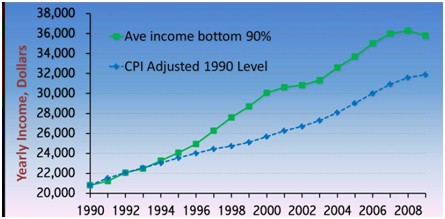
So, does it matter that the price of a goat of 100 years ago, of say a mere 5 dollars, compared to that is of today’s? The answer is, it does not. Even a thousand plus years ago, it still does not matter. This is one of the argument used by gold proponent, saying that the price of a goat of 1000 years ago (one gold coin) is essentially similar to the price of a goat of today, which is also one gold coin. Actually, this comparison is meaningless, because throughout the 1000 years, the price of goat has actually gone up and down significantly, only to get back to where it started, a thousand years ago. In fact it went up to several gold coins (hundreds of percent) and in some countries today, the price is still too high (several coins). As such, the claim that gold’s price stays the same is actually a bogus claim. We quote from the book, Secrets of The Temple, the author mentioned that an airplane is said to be ‘stable’ on the ground if one only look at the start and the finish point, forgetting that in the between, the airplane actually went up and down so high in the sky. Why bother with the value of money of 1,000 years ago, because no trade will need that long to complete?
Now, let’s dissect the claim that wealth can be stored inside a gold bar for instance. How do we store something, into something else? Believe it or not, this cannot be done no matter what. You cannot store your house into a gold bar, or you cannot store your sweat, into a gold coin. Try all you want, it cannot be done. You may convert your house into gold, only by trading it. Still, the house is not stored inside; keep that in your mind regardless!
One of the major claims of gold’s supporter to push the world into using gold as the world’s currency is that the value of gold is presumed to be stable. We have shown that gold’s value is nowhere near stable as they thought and preached. In fact, there is no one item in the world that does not change in value. Not one. We dare to challenge you, the reader, to bring us just one item in the whole wide world, that does not change in value, at all! Bring to us this one item, and perhaps the gold proponents would then have more to say. Perhaps it’s wood? Perhaps it’s ice? Perhaps iron? Or maybe plastic, oil, water or whatever it is, which may not change in value at all forever? Well until then, their feel good claim is just that, a self belief system propagated by their cronies, repeated over and over everywhere.
Since there are not one single item in the world that does not change in value (including gold and silver), then how do we expect the price of any item, to stay the same, forever? It can’t and it won’t. Everything changes in value. That’s the way the world works. You cannot store your wealth and expect its value to remain the same, five years from now. We explained this phenomenon thoroughly in our books.
So what is the real value of gold? We showed by mathematics in one of our articles in our blog (go and read them for free) that it is essentially ZERO. We explained why gold used for investment purposes has no value whatsoever. Many people would disagree with this assessment, however can they provide solid mathematical proof that it is actually valuable? Can they show the math? Can they show that it is actually as valuable as the very expensive price tag? One clue, can you survive without gold in your possession? If you can, then the value is far less than what you think it is, perhaps, as we just mentioned, it could be all the way down to zero. But can you survive without water or food in your possession? Obviously you can’t.
We are yet to mention the view of religions all over regarding hoarding gold because we don’t need to as the economics and the math already confirmed beyond any doubt what its the impact on the general economy. Don’t let ‘them’ brainwashed you into thinking that Gold is ‘religion sanctioned and approved’. Find it out from your own Quran or Bible, read it for yourself what God actually say about this piece of yellow metal!
[{As a special to all readers out there, both the authors of 259 Trillion Vs 5 Trillion book series had agreed to publish a part of Book 3 titled, “Another Take At Gold” in their website, but it is only for a very limited time (30 days). The reader would be able to find out their predictions back in 2011 where gold would be heading (they turned out to be correct on the dot!) and where gold would head next. Read it here
Sharif Rahman is the co-author of 259 Trillion Vs 5 Trillion book series and on a book explaining the Occupy Wall Street movement. He can be contacted at his email at [email protected]. The books are available in Amazon.com and for Malaysians who are interested, please do contact him on purchase information.}]
